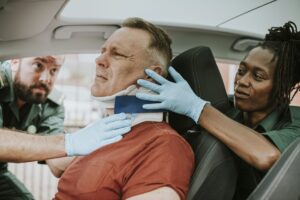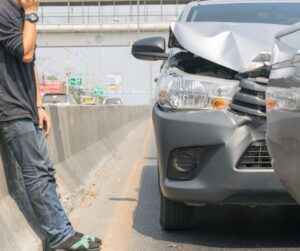
It might surprise you that foot injuries are common after car accidents. The foot is comprised of 26 bones and connects to the intricate and vital ankle joint. A foot injury can impact your ability to walk and impair your freedom. If you suffered a foot injury from a car accident, you have options. At Greenspan & Greenspan, we are here to help you.
Foot Injury from A Car Accident? It’s More Common Than You Think
Sometimes, foot injuries are immediately apparent. For instance, it is clear when you suffer a severe fracture or dislocation, but often, foot injuries can go undiagnosed for quite some time. If you are experiencing foot pain after a car accident, it is imperative that you do not ignore it and seek immediate medical attention. You may have an underlying injury that was not obvious immediately after the crash.
9 Common Foot Injuries
Foot and ankle injuries go far beyond a simple sprained ankle from a car accident. Foot injuries can be minor and temporary or severe and permanent. If you have foot or ankle pain after a car accident, it could be from one of the following injuries:
Fractures
A broken foot bone may involve a clean break or a fragmented shatter. Some fractures heal with rest and protective immobilization, while others require metal plates or screws for stability. Recovery typically involves limited weight-bearing and guided rehabilitation. People with physically active jobs may need extended leave.
Crush Injuries
Forceful compression, such as when the foot is pinned beneath a dashboard or struck by debris, can damage skin, bones, blood vessels, and nerves. These injuries often require emergency care and reconstructive surgery. Severe cases may lead to lasting impairment or amputation. Recovery is prolonged and often complicated by infections or soft tissue breakdown.
Dislocations
When joints in the foot are displaced by trauma, they may become unstable or deformed. While some dislocations can be managed with repositioning and bracing, others require surgical correction. Physical therapy is usually necessary to regain strength and mobility.
Ligament and Tendon Damage
Blunt force can stretch or tear connective tissues, leading to swelling, stiffness, and pain. Milder strains respond well to conservative treatment, while full-thickness tears may need surgical repair. Recovery varies based on severity and treatment type.
Lisfranc Injuries
The Lisfranc joint complex connects the forefoot to the midfoot. Twisting injuries or heavy pressure can dislocate these joints or tear stabilizing ligaments. Because symptoms mimic other foot injuries, diagnosis is often delayed. Many Lisfranc injuries require surgery and a long recovery that may include months of non-weight-bearing restrictions.
Compartment Syndrome
Swelling or bleeding inside the foot can increase pressure within confined spaces, blocking circulation and damaging tissue. Without prompt surgical intervention, this condition can cause permanent loss of function.
Metatarsal Injuries
The long bones in the midfoot are prone to stress fractures or complete breaks from direct force. These injuries often cause localized swelling and pain when bearing weight. Depending on the severity of the injury, treatment may involve casting, booting, or limited activity for several weeks.
Heel (calcaneus) Fractures
Calcaneus fractures may occur if the heel absorbs a substantial impact, such as being driven into the car floor or ground. These injuries often flatten the arch and impair balance. Treatment may involve surgical reconstruction and extensive rehabilitation.
Toe Injuries
The toes are vulnerable when feet slide forward or strike hard surfaces during collisions. Fractures, sprains, or dislocations can affect stability, particularly if the big toe is involved. Most cases heal with splinting or rest, though severe trauma may require more intensive care.
Each of these injuries can range in severity and duration. Seeking immediate medical attention will ensure a proper diagnosis and treatment.
Steps to Take After a Foot Injury
Whether it is obvious you suffered a foot injury after a car accident or you just suspect it, there are essential steps to take.
Step 1: Seek Immediate Medical Attention
The priority after a car accident is to seek medical treatment. Any delay in treatment can worsen the injury. Always keep all documentation, including medical records, bills, and invoices.
Step 2: Contact a Personal Injury Lawyer
Once you are physically able, you should consult with a personal injury attorney. Getting legal representation early gives you the advantage of having someone handle all contact with the insurance company. A seasoned lawyer will handle all communications and ensure you meet all applicable deadlines.
Step 3: Negotiate with the Insurance Company
Once you understand the extent of your injury and gather the necessary supporting documents, it is time to send a formal demand for damages to the insurance company. If you have hired an attorney, they will do this for you. The demand typically outlines the facts of the case, your injuries, other damages, and the compensation you request. This begins the formal negotiating process.
If you cannot agree with the insurance company, it is time to discuss filing a personal injury lawsuit with your attorney. In New York, you generally have only three years to do this, so it is imperative to consult with your attorney promptly. Remember, every situation is unique, and your claim might not follow this trajectory. Your attorney will guide you in the right direction.
Damages from a Foot Injury
Like any potential injury, you may be eligible to seek damages for your foot injury. Compensation can include economic and noneconomic damages, and the precise amount will depend on several factors specific to your case. These include:
- Severity of the injury,
- Insurance policy limits, and
- Overall prognosis.
Economic damages compensate accident victims for their financial losses, including medical expenses, lost wages, and property damage (e.g., the cost of repairing or replacing their vehicle).
Noneconomic damages are more subjective to the individual and will compensate a plaintiff for the negative impact the injury has had on their life. These include:
- Pain and suffering,
- Emotional distress,
- Loss of consortium, and
- Loss of enjoyment of life.
An experienced attorney will advocate for the maximum amount of compensation available to you.
Foot Injury From a Car Accident?
We are here to help. We understand you might be unable to work, suffering in pain, and unsure of what to do next. Since 1959, we have helped New Yorkers seek the compensation they rightfully deserve for harm done to them. Contact us today to schedule your no-cost consultation with an experienced attorney on our team.







